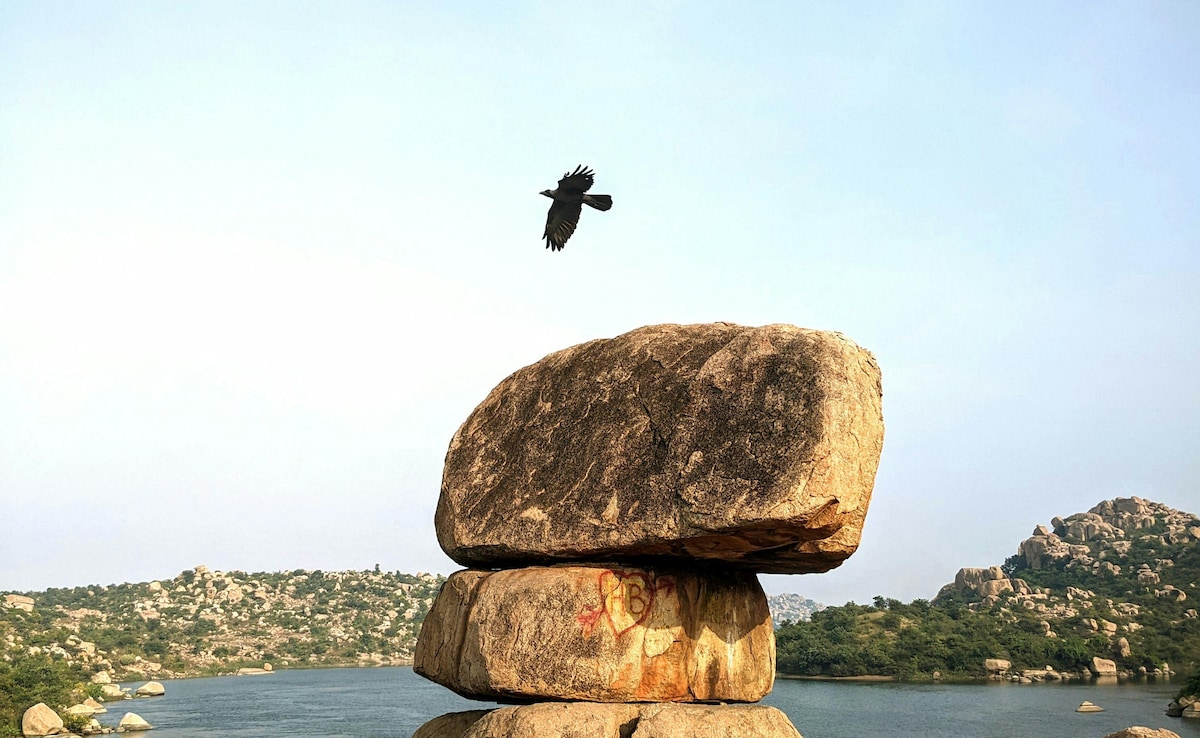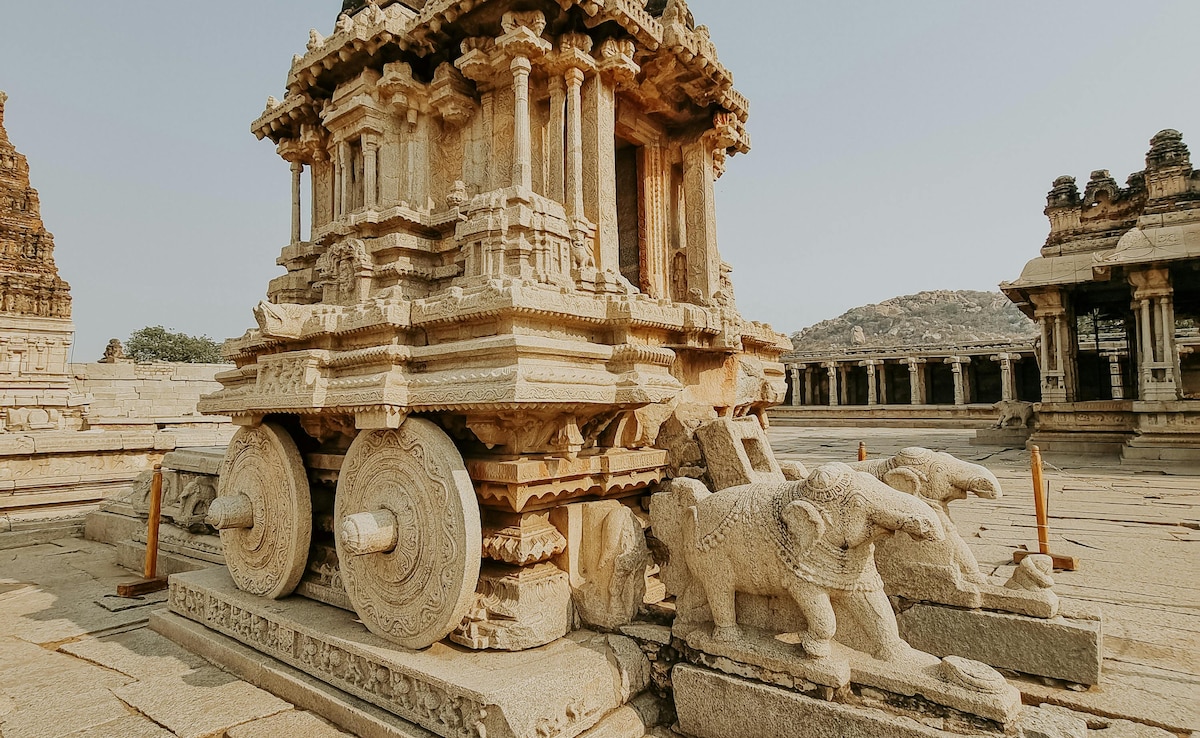
If there is one place in India that feels paused in time, it is Hampi, set along the banks of the Tungabhadra River in Karnataka. Scattered with house-sized granite boulders, temples that resemble cinematic sets, and a landscape that feels almost mythological, Hampi is more than just a historic site. It is where myth and memory live side by side, where each stone whispers a tale, and the past is not simply remembered but felt. Today, though, Hampi is not only about history.
It has become a haven for photographers, yoga travellers, solo backpackers, and heritage lovers. Alongside its monumental ruins, what gives Hampi its soul is the wildly diverse terrain: enormous boulders, lush rice fields, banana groves, the sacred Matanga Hill, and the ever-flowing Tungabhadra River carving its way through centuries.
Also Read: 5 UNESCO World Heritage Sites In India That Are Extra Magical During The Monsoon

Photo Credit: Pexels
Hampi's Grand Past: Once A Flourishing Capital
Founded in 1336 CE by Harihara and Bukka, Hampi was the capital of the Vijayanagara Empire. For more than two centuries, it thrived as a cultural, political, and economic centre. According to the Archaeological Survey of India (ASI), Hampi was once larger than Rome and boasted palaces said to be more magnificent than those in Lisbon.
Persian ambassador Abdul Razaak, who visited in the 15th century, wrote, "The city is such that the pupil of the eye has never seen a place like it, and the ear of intelligence has never been informed that there existed anything to equal it in the world."
However, in 1565, following the Battle of Talikota, the city fell to the Deccan Sultanates. Six months of looting followed, leaving behind the haunting, wind-battered ruins that remain.
Despite its destruction, Hampi's architectural and cultural grandeur remains unmatched. According to KarnatakaTourism.org, the site stretches across 29 square kilometres, earning the title of the "World's Largest Open-Air Museum." From elaborately carved temples to elephant stables, aqueducts, market streets, and watchtowers, every corner reflects the sophistication of a lost empire.
Hampi Is A UNESCO World Heritage Site
Recognised as a UNESCO World Heritage Site in 1986, Hampi is celebrated for its distinct Dravidian architecture and thoughtfully planned layouts. The ruins are primarily divided into two zones:
- The Royal Centre: Located in the southwest, this area was once home to palaces, pavilions, stables, and ceremonial temples.
- The Sacred Centre: Built around the Virupaksha Temple and Hampi Bazaar, this section runs along the river and includes temples still active today.
Both areas reflect the seamless link between spirituality and power, and why Hampi was once regarded as one of the greatest cities of its age.
Also Read: 7 UNESCO-Listed Natural Wonders In India That'll Leave You Speechless

Photo Credit: Pexels
Top Historical Attractions In Hampi
KarnatakaTourism.org says that Hampi's ruins are so extensive that they can easily take days to fully experience. Here are the key sites to prioritise:
- Virupaksha Temple: Among India's oldest active temples, dedicated to Lord Shiva, with a 160-foot-tall tower.
- Vittala Temple: Famous for its Stone Chariot and musical pillars, it is a textbook example of Vijayanagara architecture.
- Hemakuta Hill: A quiet spot for sunrise, with scattered shrines and open views.
- Lotus Mahal: Nestled within the Zenana Enclosure, this elegant structure features Indo-Islamic design.
- Elephant Stables: Majestic domed structures once used to house royal elephants.
- Hippie Island (Virupapur Gadde): Across the river, this peaceful area offers cafés, huts, and green paddy fields.
Also Read: 6 UNESCO World Heritage Sites In India That Are Totally Worth The Hype
Best Places To Stay In Hampi:
From heritage-style resorts to low-key riverside retreats, Hampi has stay options for every kind of traveller.
1. Heritage Resorts And Boutique Hotels
For those interested in regal ambience and comfort, boutique resorts near the ruins offer a quiet escape. Many of these feature stunning traditional architecture, courtyards, and design that reflect the region.
Top picks:
- Kishkinda Heritage Resort
- Heritage Resort Hampi
- WelcomHeritage Shivavilas Palace Hotel
2. Homestays And Guesthouses
In Hampi and neighbouring Anegundi village, several family-run homestays provide a taste of local life and home-cooked food.
Top picks:
- Little Banan Homestay
- Saptami Hampi Homestay
- Archana Guest House
3. Budget Hostels For Backpackers
Perfect for solo travellers and those on a budget, hostels offer dorm beds, shared lounges, and a lively community.
Top picks:
- Zostel Hampi
- Nihira B&B
- Hearth Space
4. Eco Huts And Riverside Cafes On Hippie Island
Across the river, Hippie Island is full of bamboo huts, eco lodges, and cafés set among paddy fields.
Top picks:
- Rasta Cafe
- Mowgli Cafe
- Evergreen Cafe
Booking tips:
- Hippie Island stays are often seasonal and may shut during monsoons or religious festivals.
- Winter and Hampi Utsav season get busy, so advance booking is ideal.
- Stays near Hampi Bazaar or Kamalapur are best for sightseeing access.

Photo Credit: Pexels
Where To Eat: Best Food Spots In Hampi
1. Hampi Bazaar (Near Virupaksha Temple):
Try traditional South Indian breakfasts like dosas, idlis, and filter coffee. Small stalls also serve thalis, lemon rice, and fruit juices - perfect for a quick and affordable lunch between temple visits.
2. Janata Plot Lane:
Hidden cafés serve banana pancakes, fresh chapatis, Israeli platters, and home-style meals. The vibe is relaxed and great for travellers looking to linger.
3. Virupapur Gadde (Hippie Island):
Known for bohemian cafés serving falafels, Tibetan momos, smoothie bowls, and wood-fired pizzas - often on floor cushions with a side of live music.
4. Kamalapur Market:
Closer to the Royal Centre, this spot is great for no-fuss local fare: poori-bhaji, spicy Karnataka-style curries, and sambhar rice in small canteens.
5. Anegundi Village:
Quiet and traditional, this village has stalls and cafés serving millet rotis, ragi dosas, and home-made chutneys - ideal after a coracle ride or village walk.
What To Buy In Hampi: Local Souvenirs And Crafts
1. Stone Sculptures:
Miniatures of Nandi bulls, Shiv Lingas, temples, and lamps made from local stone are sold near Virupaksha Temple and Hampi Bazaar.
2. Lambani Embroidery:
At Sandur Kushala Kala Kendra, tribal women sell embroidered bags, belts, and home decor featuring coins, mirrors, and bright threads.
3. Leather Goods:
Handcrafted leather bags and puppets are found on Hippie Island.
4. Tribal Jewellery:
Chunky metal accessories, coin necklaces, and quirky pieces fill Hampi Bazaar's stalls.
5. Books And Postcards:
The Archaeological Museum in Kamalapur has history books and scenic postcards worth browsing.

Photo Credit: Pexels
Best Time To Visit Hampi:
- October to February: Ideal weather and Hampi Utsav celebrations.
- March to May: Extremely hot; not recommended.
- June to September: Green and scenic, but trails may be slippery due to rain.
How To Reach Hampi:
1. By Train:
Hospet Junction is the nearest railhead (13 km away), with easy access to Hampi by rickshaw or taxi.
2. By Bus:
Government and private buses connect Hampi to Bengaluru, Hyderabad, Goa, and Hubballi.
3. By Air:
- Vidyanagar Airport: Nearest (35 km) with limited flights.
- Hubballi Airport: 217 km away with regional flights.
- Kempegowda International Airport, Bengaluru: 290 km away, ideal for international travellers.
4. By Road:
From Bengaluru, it is a 6-7 hour scenic drive through villages and hills.
Traveller Tips For Hampi:
- Begin your day early to avoid the heat.
- Wear light clothes and shoes suited for uneven terrain.
- Dress modestly, especially around temple zones.
- Mobile networks may be patchy - carry offline maps and essentials.
- As per Karnataka Tourism, walking, renting a scooter, or cycling are the best ways to explore the ruins.
Whether you are cycling past ancient ruins, sailing on a coracle, or sipping chai by the river, Hampi offers more than a trip - it offers a pause, a memory, and a place that stays with you long after you leave.
Track Latest News Live on NDTV.com and get news updates from India and around the world

